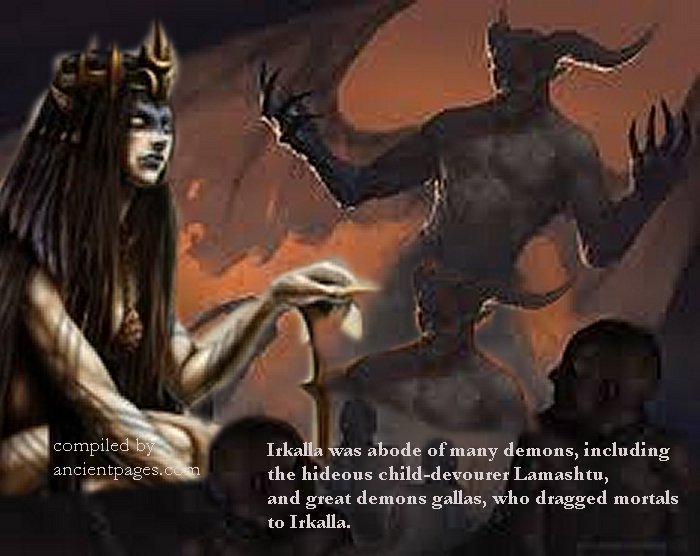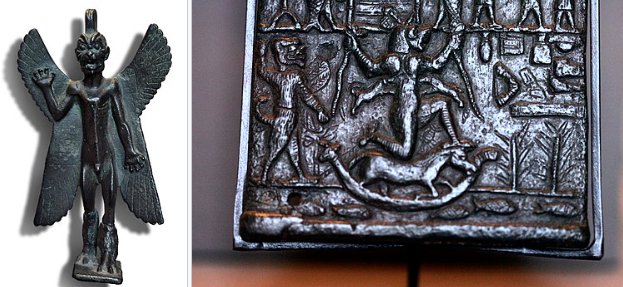Irkalla – Underworld With No Return Ruled By Ereshkigal, Granddaughter Of Enlil And Sister Of Inanna
A. Sutherland - AncientPages.com - In Babylonian mythology, Irkalla was the underworld from which there was no return. The realm of the dead or the lower world was also called Arali, Kur, Kigal, and Gizal.
There were two traditions explaining how humans entered the netherworld. According to one, the road to the underworld passed through the steppe land swarming with demons, across the Khabur River, and then through seven heavily guarded gates.
Another version described a road to the netherworld crossed by boat down one of the rivers of the upper earth. Then, across the apsu (the sweet waters under the earth) to Irkalla, the lower earth.
At first, the only ruler of Irkalla was Ereshkigal ("Queen of the Great Below"), a granddaughter of Enlil and older sister of Inanna (Ishtar). Later she ruled the netherworld with her husband, Nergal, the king of death who brings disease, plague, and all misfortunes caused by heat. Ereshkigal's judgment and laws were always indisputable.
Irkalla was the abode of many demons, including the hideous child-devourer Lamashtu, the fearsome wind demon and protector god Pazuzu, and great demons Gallas (or Gallu) busy with dragging mortals to Irkalla.
Location Of Irkalla
Based on various texts, it can be assumed that the Babylonians located the entrance to the underground world, where the sunset was in the western desert.
Left: Bronze statuette of Pazuzu (c. 800 – c. 700 BC). Credit: Public Domain - Right: Close-up of Lamashtu from a lead protection plaque dating to the Neo-Assyrian Period (911 – 609 BC). Credit: Public Domain
The Babylonian sun god, Shamash, descended to these regions in the evening. Then, he appeared again from the mountains in the east in the morning. The netherworld was situated even lower than the Abzu, the fresh-water ocean beneath the earth.
Grave Of The Deceased – The Entrance To Irkalla
In Babylonian writings, the grave was the entrance to the underground world for the man who was buried in it. The Sumerian beliefs inspired the Babylonian myths, which were later repeated and further developed.
All people, regardless of their positions, age or morals, descended after death to Irkalla. It was the same afterlife for all souls.
The only food or drink was dry dust, but family members of the deceased would pour libations for them to drink.
In "The Ark Before Noah: Decoding the Story of the Flood," Irving Finkel cites a description of Irkalla as a dreary place: The netherworld was described as a dreary place:
To the gloomy house, seat of the netherworld,
To the house which none leaves who enters,
To the road whose journey has no return,
To the house whose entrants are bereft of light,
Where dust is their sustenance and clay their food.
They see no light but dwell in darkness,
They are clothed like birds in wings for garments,
And dust has gathered on the door and bolt..."
(The Descent of Ishtar to the Netherworld" 4-11)
Not all views of the afterlife were the same among ancient beliefs of other cultures.
Unlike other views of the afterlife, in the Sumerian underworld, there was no final judgment of the deceased. The dead were neither punished nor rewarded for their deeds in life. Their burial conditions determined a person's quality of existence in the underworld.
Ancient Sumerian cylinder seal impression showing the god Dumuzid being tortured in the underworld by galla demons. Credit: Public Domain
As the dark underground realm, cut off from life and God, Irkalla was the ultimate destination for all who died. The domain is similar to Sheol (She'ol) of the Hebrew Bible, where all the dead - righteous and the unrighteous – must meet. It happens regardless of the moral choices and deeds made in life.
But at the same time, it is very different from more hopeful visions of the afterlife that later appeared in Platonic philosophy, Judaism, and Christianity, unlike visions of the ancient Egyptian afterlife.
After crossing the Hubur river, the deceased (naked or clothed in feathers like birds) stood in front of the seven city walls and had to pass through seven gates guarded by the guards. The ruler would pronounce them dead, and their names would be recorded on a tablet by a scribe.
In Irkalla, the deceased had to face Ereshkigal as they were born – naked, without garments and personal ornaments.
Written by – A. Sutherland AncientPages.com Senior Staff Writer
Updated on October 5, 2022
Copyright © AncientPages.com All rights reserved. This material may not be published, broadcast, rewritten or redistributed in whole or part without the express written permission of AncientPages.com
Expand for referencesReferences:
Black J., Green A. Gods, Demons and Symbols of Ancient Mesopotamia
Finkel I. The Ark Before Noah: Decoding the Story of the Flood"
More From Ancient Pages
-
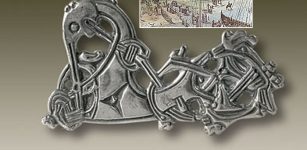 Kaupang – Flourishing Viking Town – A Commercial Hub And Transit Port For North Sea Trade
Featured Stories | Feb 2, 2023
Kaupang – Flourishing Viking Town – A Commercial Hub And Transit Port For North Sea Trade
Featured Stories | Feb 2, 2023 -
 New Evidence Of Roman And Medieval Leicester
Archaeology | Dec 10, 2015
New Evidence Of Roman And Medieval Leicester
Archaeology | Dec 10, 2015 -
 Secret Passageways And Caves Beneath UK’s City Of Nottingham
Featured Stories | Feb 14, 2023
Secret Passageways And Caves Beneath UK’s City Of Nottingham
Featured Stories | Feb 14, 2023 -
 Discovery At Fujiwarakyu Palace Complex Offers Better Glimpse Of 7th-Century Japan
Archaeology | Oct 21, 2015
Discovery At Fujiwarakyu Palace Complex Offers Better Glimpse Of 7th-Century Japan
Archaeology | Oct 21, 2015 -
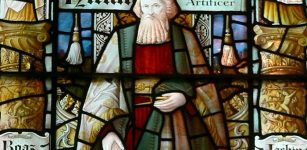 Legendary Hiram Abiff – Master And Chief Architect Loved By Few And Hated By Many Including King Solomon
Featured Stories | Jan 27, 2019
Legendary Hiram Abiff – Master And Chief Architect Loved By Few And Hated By Many Including King Solomon
Featured Stories | Jan 27, 2019 -
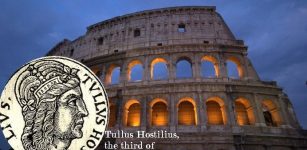 Tullus Hostilius: Warrior King Of Rome, Who Succeeded Numa Pompilius And Feared Prophecies
Featured Stories | Mar 6, 2019
Tullus Hostilius: Warrior King Of Rome, Who Succeeded Numa Pompilius And Feared Prophecies
Featured Stories | Mar 6, 2019 -
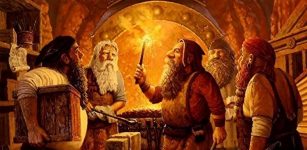 Brokkr And Eitri – Norse Dwarves Who Fashioned Magical Artifacts For The Gods
Featured Stories | Aug 19, 2019
Brokkr And Eitri – Norse Dwarves Who Fashioned Magical Artifacts For The Gods
Featured Stories | Aug 19, 2019 -
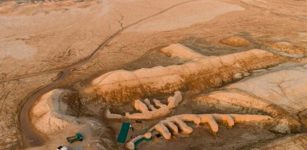 Sumerians Built A Huge ‘Anti-Drought Machine’ To Save Ancient City Of Girsu From Destruction
Ancient Technology | Nov 23, 2023
Sumerians Built A Huge ‘Anti-Drought Machine’ To Save Ancient City Of Girsu From Destruction
Ancient Technology | Nov 23, 2023 -
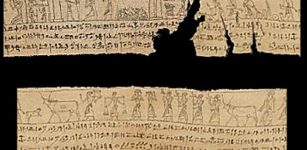 300 BC Mummy Shroud Fragment In NZ Finds Match In US
Archaeology | Jul 18, 2021
300 BC Mummy Shroud Fragment In NZ Finds Match In US
Archaeology | Jul 18, 2021 -
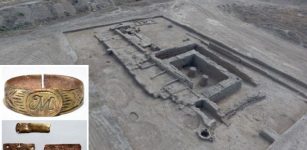 Stunning Ancient Khanqah With Large Underground Crypt, Ritual Halls And Burials Discovered In Turkestan
Archaeology | Aug 14, 2020
Stunning Ancient Khanqah With Large Underground Crypt, Ritual Halls And Burials Discovered In Turkestan
Archaeology | Aug 14, 2020 -
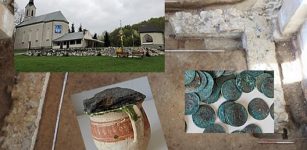 Unique Treasure Of 500 Coins Accidentally Found Under Church Floor In Slovakia
Archaeology | Apr 6, 2020
Unique Treasure Of 500 Coins Accidentally Found Under Church Floor In Slovakia
Archaeology | Apr 6, 2020 -
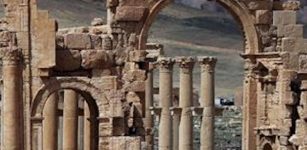 Arch Of Triumph In 2000-Year-Old City Of Palmyra – Destroyed
Archaeology | Oct 5, 2015
Arch Of Triumph In 2000-Year-Old City Of Palmyra – Destroyed
Archaeology | Oct 5, 2015 -
 Why Is The History Of Striped Clothing Dark And Sinister?
Ancient History Facts | Jan 30, 2023
Why Is The History Of Striped Clothing Dark And Sinister?
Ancient History Facts | Jan 30, 2023 -
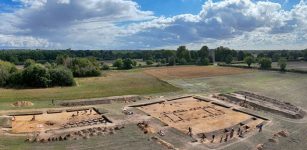 Huge 1,400-Year-Old Hall Of The First Kings Of East Anglia Discovered In Rendlesham
Archaeology | Oct 5, 2022
Huge 1,400-Year-Old Hall Of The First Kings Of East Anglia Discovered In Rendlesham
Archaeology | Oct 5, 2022 -
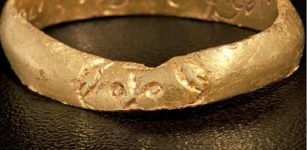 Skulls and inscriptions on three rings found by archaeologists in Wales
Artifacts | Aug 29, 2015
Skulls and inscriptions on three rings found by archaeologists in Wales
Artifacts | Aug 29, 2015 -
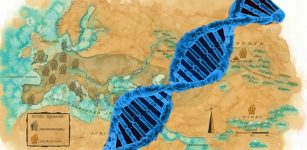 Genetic Fingerprints Of Unknown Species Discovered In Human DNA
Human Beginnings | Dec 31, 2019
Genetic Fingerprints Of Unknown Species Discovered In Human DNA
Human Beginnings | Dec 31, 2019 -
 Extraordinary Fossils From The End Of The Age Of The Dinosaurs – Study
Paleontology | Oct 15, 2023
Extraordinary Fossils From The End Of The Age Of The Dinosaurs – Study
Paleontology | Oct 15, 2023 -
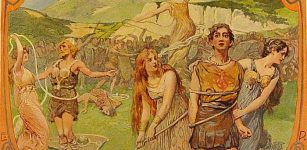 Disir: Elusive Female Guardian Spirits Of Fate And Harbingers Of Death And War
Featured Stories | Aug 28, 2023
Disir: Elusive Female Guardian Spirits Of Fate And Harbingers Of Death And War
Featured Stories | Aug 28, 2023 -
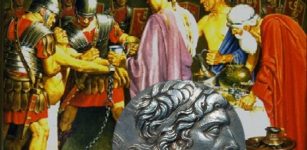 King Mithradates VI Of Pontus Used Poison To Avoid Death By Poison
Ancient History Facts | Mar 5, 2016
King Mithradates VI Of Pontus Used Poison To Avoid Death By Poison
Ancient History Facts | Mar 5, 2016 -
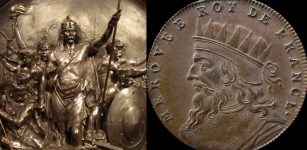 Merovech – Legendary King Of The Franks And The Merovingian Dynasty
Featured Stories | Jan 18, 2019
Merovech – Legendary King Of The Franks And The Merovingian Dynasty
Featured Stories | Jan 18, 2019

